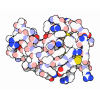[English] 日本語
 Yorodumi
Yorodumi- PDB-1oyu: Long-Distance conformational changes in a protein engineered by m... -
+ Open data
Open data
- Basic information
Basic information
| Entry | Database: PDB / ID: 1oyu | ||||||
|---|---|---|---|---|---|---|---|
| Title | Long-Distance conformational changes in a protein engineered by modulated sequence duplication | ||||||
 Components Components | Lysozyme | ||||||
 Keywords Keywords | HYDROLASE / sequence duplication / design of structural switches / tandem repeat / protein design | ||||||
| Function / homology |  Function and homology information Function and homology informationviral release from host cell by cytolysis / peptidoglycan catabolic process / cell wall macromolecule catabolic process / lysozyme / lysozyme activity / host cell cytoplasm / defense response to bacterium Similarity search - Function | ||||||
| Biological species |  Enterobacteria phage T4 (virus) Enterobacteria phage T4 (virus) | ||||||
| Method |  X-RAY DIFFRACTION / X-RAY DIFFRACTION /  SYNCHROTRON / SYNCHROTRON /  MOLECULAR REPLACEMENT / Resolution: 2.5 Å MOLECULAR REPLACEMENT / Resolution: 2.5 Å | ||||||
 Authors Authors | Sagermann, M. / Gay, L. / Matthews, B.W. | ||||||
 Citation Citation |  Journal: Proc.Natl.Acad.Sci.USA / Year: 2003 Journal: Proc.Natl.Acad.Sci.USA / Year: 2003Title: Long-distance conformational changes in a protein engineered by modulated sequence duplication Authors: Sagermann, M. / Gay, L. / Matthews, B.W. #1:  Journal: Proc.Natl.Acad.Sci.USA / Year: 1999 Journal: Proc.Natl.Acad.Sci.USA / Year: 1999Title: Structural characterization of an engineered tandem repeat contrasts the importance of context and sequence in protein folding Authors: Sagermann, M. / Baase, W.A. / Matthews, B.W. | ||||||
| History |
|
- Structure visualization
Structure visualization
| Structure viewer | Molecule:  Molmil Molmil Jmol/JSmol Jmol/JSmol |
|---|
- Downloads & links
Downloads & links
- Download
Download
| PDBx/mmCIF format |  1oyu.cif.gz 1oyu.cif.gz | 81.4 KB | Display |  PDBx/mmCIF format PDBx/mmCIF format |
|---|---|---|---|---|
| PDB format |  pdb1oyu.ent.gz pdb1oyu.ent.gz | 61.7 KB | Display |  PDB format PDB format |
| PDBx/mmJSON format |  1oyu.json.gz 1oyu.json.gz | Tree view |  PDBx/mmJSON format PDBx/mmJSON format | |
| Others |  Other downloads Other downloads |
-Validation report
| Summary document |  1oyu_validation.pdf.gz 1oyu_validation.pdf.gz | 437.8 KB | Display |  wwPDB validaton report wwPDB validaton report |
|---|---|---|---|---|
| Full document |  1oyu_full_validation.pdf.gz 1oyu_full_validation.pdf.gz | 461.6 KB | Display | |
| Data in XML |  1oyu_validation.xml.gz 1oyu_validation.xml.gz | 18.4 KB | Display | |
| Data in CIF |  1oyu_validation.cif.gz 1oyu_validation.cif.gz | 25.3 KB | Display | |
| Arichive directory |  https://data.pdbj.org/pub/pdb/validation_reports/oy/1oyu https://data.pdbj.org/pub/pdb/validation_reports/oy/1oyu ftp://data.pdbj.org/pub/pdb/validation_reports/oy/1oyu ftp://data.pdbj.org/pub/pdb/validation_reports/oy/1oyu | HTTPS FTP |
-Related structure data
| Related structure data | 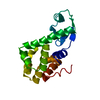 3lzmS S: Starting model for refinement |
|---|---|
| Similar structure data |
- Links
Links
- Assembly
Assembly
| Deposited unit | 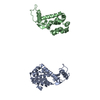
| ||||||||
|---|---|---|---|---|---|---|---|---|---|
| 1 | 
| ||||||||
| 2 | 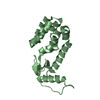
| ||||||||
| Unit cell |
| ||||||||
| Details | Two molecules in the asymmetric unit, A and B, refinement was carried out in the absence of NCS relationship |
- Components
Components
| #1: Protein | Mass: 19513.361 Da / Num. of mol.: 2 Source method: isolated from a genetically manipulated source Source: (gene. exp.)  Enterobacteria phage T4 (virus) / Genus: T4-like viruses / Species: Enterobacteria phage T4 sensu lato / Plasmid: phs1403 / Production host: Enterobacteria phage T4 (virus) / Genus: T4-like viruses / Species: Enterobacteria phage T4 sensu lato / Plasmid: phs1403 / Production host:  #2: Water | ChemComp-HOH / | |
|---|
-Experimental details
-Experiment
| Experiment | Method:  X-RAY DIFFRACTION / Number of used crystals: 1 X-RAY DIFFRACTION / Number of used crystals: 1 |
|---|
- Sample preparation
Sample preparation
| Crystal | Density Matthews: 2.49 Å3/Da / Density % sol: 50.7 % | ||||||||||||||||||||||||||||||
|---|---|---|---|---|---|---|---|---|---|---|---|---|---|---|---|---|---|---|---|---|---|---|---|---|---|---|---|---|---|---|---|
| Crystal grow | Temperature: 298 K / Method: vapor diffusion, hanging drop / pH: 5.5 Details: 25% poly-ethylene glycol 4000, 50mM phosphate buffer, 0.2mM ammonium acetate, 20% isopropanol, pH 5.5, VAPOR DIFFUSION, HANGING DROP, temperature 298K | ||||||||||||||||||||||||||||||
| Crystal grow | *PLUS Temperature: 4 ℃ / Method: vapor diffusion | ||||||||||||||||||||||||||||||
| Components of the solutions | *PLUS
|
-Data collection
| Diffraction | Mean temperature: 170 K |
|---|---|
| Diffraction source | Source:  SYNCHROTRON / Site: SYNCHROTRON / Site:  SSRL SSRL  / Beamline: BL7-1 / Wavelength: 0.99 Å / Beamline: BL7-1 / Wavelength: 0.99 Å |
| Detector | Type: MARRESEARCH / Detector: IMAGE PLATE / Date: Nov 10, 2001 / Details: mirrors |
| Radiation | Monochromator: Flat mirror, single SI crystal bend / Protocol: SINGLE WAVELENGTH / Monochromatic (M) / Laue (L): M / Scattering type: x-ray |
| Radiation wavelength | Wavelength: 0.99 Å / Relative weight: 1 |
| Reflection | Resolution: 2.5→36.62 Å / Num. obs: 13538 / % possible obs: 94.8 % / Observed criterion σ(F): 0 / Observed criterion σ(I): 0 / Redundancy: 6.8 % / Biso Wilson estimate: 43.7 Å2 / Rsym value: 0.072 / Net I/σ(I): 8.2 |
| Reflection shell | Resolution: 2.5→2.64 Å / Redundancy: 5.21 % / Mean I/σ(I) obs: 3.3 / Num. unique all: 2047 / Rsym value: 0.22 / % possible all: 96.6 |
| Reflection | *PLUS Num. obs: 12441 / Rmerge(I) obs: 0.072 |
- Processing
Processing
| Software |
| |||||||||||||||||||||
|---|---|---|---|---|---|---|---|---|---|---|---|---|---|---|---|---|---|---|---|---|---|---|
| Refinement | Method to determine structure:  MOLECULAR REPLACEMENT MOLECULAR REPLACEMENTStarting model: PDB ENTRY 3lzm Resolution: 2.5→37 Å / Isotropic thermal model: Anisotropic / Cross valid method: THROUGHOUT / σ(F): 0 / Stereochemistry target values: Engh & Huber Details: In molecule A, the density between residues 53-64 is very poor. The occupancy of these atoms has been set to zero. In Molecule B, the density for the main chain was clearly visible in OMIT ...Details: In molecule A, the density between residues 53-64 is very poor. The occupancy of these atoms has been set to zero. In Molecule B, the density for the main chain was clearly visible in OMIT maps, however, the density is weak and no side chain density could be identified. After several trials of refinement, the occupancy has been set to 0.6 for atoms of residues 53-64. Also, the final amino acids Asn174 and Leu175 could not be localized in the structure.
| |||||||||||||||||||||
| Displacement parameters |
| |||||||||||||||||||||
| Refinement step | Cycle: LAST / Resolution: 2.5→37 Å
| |||||||||||||||||||||
| Refine LS restraints |
| |||||||||||||||||||||
| Software | *PLUS Name: CNS / Version: 1.1 / Classification: refinement | |||||||||||||||||||||
| Refinement | *PLUS | |||||||||||||||||||||
| Solvent computation | *PLUS | |||||||||||||||||||||
| Displacement parameters | *PLUS | |||||||||||||||||||||
| Refine LS restraints | *PLUS
|
 Movie
Movie Controller
Controller


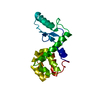
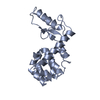
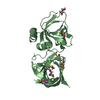
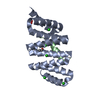
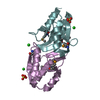
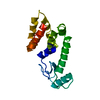
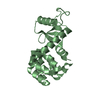
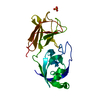

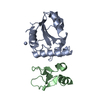

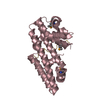
 PDBj
PDBj